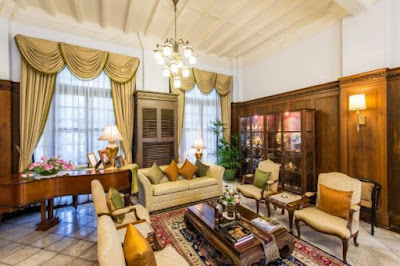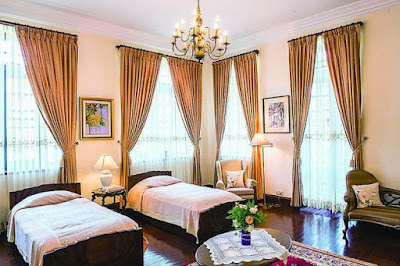.
Beyond the beaches, the old walled town teems with historical and cultural charms
WHILE
MOST of the travelers arriving in Trang quickly find a perch on the
beach or head straight to the boats to go diving in the Andaman Sea, the
tranquil town itself offers all sorts of landlubber delights.
Trang was a thriving trading hub in the days when it was known as Muang Thub Thieng, a port established by Chinese merchants.
In the days of the Sumatra-based Melayu Kingdom between 600 and 1200
AD, vessels docked there laden with kerosene for lamps and ingredients
for making pastry. When they departed, they were filled with locally
grown pepper.
.
In 1899 the area became the first place where rubber was planted in
Siam. A man called Phraya Ratsadanupradit Mahison Phakdi brought the
saplings from Malaya and built up an export business.
.
.
On my first visit to Trang I’m impressed with the diversity of
culture, with Western-style churches sitting alongside Chinese shrines,
Thai temples and Muslim mosques, as if to demonstrate the benefits of
living in harmony.
My host is tourism promoter Ko Daeng, who
with his friends arranges day-trips around town for visitors, charging
Bt250 per hour or Bt650 for a four-hour tour. You get to see the sights
in a frog-nosed tuk-tuk imported from Japan.
“Some of our
vehicles were built 100 years ago,” Ko Daeng says. “We modify the
engines so they can carry people. It’s a way to conserve our heritage –
these kinds of vehicles were popular here in the past, so we thought it
would be a good way to promote tourism, using tuk-tuks.”
.
.
Ko Daeng ’s operation has a list of 17 destinations to choose among, and I pointed to the Tam Kong Yia Shrine.
Erected more than a century ago, the temple attracts worshipers seeking
success and good health. In its foundation are sacred ashes and a cloth
talisman that the founder brought with him from the Nine Dragons Temple
in Huizhou, China, to protect him on the voyage to Siam.
The
structure has some amazing craftsmanship that was carefully preserved
during a 1953 renovation. Sunlight pours in through the open roof to
illuminate statues of goddesses, lending the place a mystical
atmosphere.
A few minutes’ drive away is Wat Kaphang Surin,
designated a National Ancient Monument in 1999. Constructed in 1897 as
Wat Kaphang, it was renamed in honour of esteemed local developer Phraya
Surin Racha.
The original wood-and-cement ubosot reflects
traditional southern architecture. Inside is a series of 100-year-old
wood or metal figures depicting the Lord Buddha in different poses.
Sections of the ancient wall surrounding the old town have recently
been decorated with three-dimensional paintings. There are scenes of the
local life, rubber plantations and the Emerald Cave on Koh Mook, every
one a magnet for selfie shooters.
.
.
At the Tha Klang intersection nearby, a string of old two-storey
buildings are painted in pastel colours. At least there was some charm
to the Portuguese colonial era, when the architecture became a hybrid of
Chinese and European design and bright hues were the norm on exteriors.
But most of these buildings date to 1913, originally the homes of
wealthy Chinese merchants. They also have in common narrow entrances,
roofs open over a central courtyard and a shared arcade out front that
offers passers-by shade and shelter. The houses at the corners of the
block feature curving edges and diamond-shaped tiles on the roof.
Along Rama VI and Ratchadam- noen Roads is a shopping district that
includes the town’s oldest hotel, the Jing Jing, recognised by the
Associ- ation of Siamese Architects last year for its “valuable
architecture”.
There’s also the celebrated Chinese pharmacy Yin
Jiee Thong, home – along with its ancient medicines – to the original
Trang grilled pork, made with local spices and herbs. Classic shophouses
along the avenue are stocked with furniture, bicycles, apparel,
cosmetics and much more.
Also striving to conserve local culture,
a group called Trang Positive has the support of the Tourism Authority
in hosting the annual “Yan Kao Ngao A-deed”. It comprises an art
exhibition, student-orchestra performances and lively talks about, for
example, the local cuisine. Visitors can learn how to make Tae
Chew-style mee tiew, stewed chicken in red sauce and mor lao (deep-fried
dumplings).
.
.
The splendid natural scenes outside town are perhaps best at Baan
Khao Lak in Namphud district, where you can paddle a canoe along a
canal. The community has set itself up as a model of sufficiency living
and nature conservation.
Once finished their farm chores, the
residents take visitors on four-kilometre canoe “cruises” amid cool
forests and limestone bluffs sculpted by wind and water into interesting
shapes. Back in the village you can learn how to make local desserts or
a wicker souvenir.
“I started the project three years ago to
help people earn extra income,” village head Sawat Khunnui tells us. “We
take people trekking in a watershed forest or canoeing, and there will
be also a home-stay programme. It’s all about conserving the
environment. We set up a ‘waste bank’, too, and donate recycled material
to a school.”
Another great place to visit is Baan Na Por,
which has a factory full of skilled cutlers making knives, hoes and even
swords from the leaf springs of old buses. Prawet Chitjan, 58, a
fifth-generation member of a family of cutlers, runs the operation. Long
ago he left home to get a city job, but in 1987 decided to return and
do his part to salvage the local wisdom.
.
Artisans at Baan Na Por make knives that are in professional demand around the country.
.
The
factory produces the 55-brand and Three Star knives popular with rubber
tappers and farmers in the South and Northeast. The prices range from
Bt160 to Bt650.
“We use crafting techniques that have been
passed on from generation to generation for more than 100 years,” Uncle
Prawet says. “We believe that two villagers – Nai Petch and Nai Kong –
discovered one technique whereby ship spikes were turned into garden
tools, and then the quality is enhanced through different designs and
materials.
“Next, I’m building a museum to exhibit all the old types of agricultural tools and house a mock-up cutlery factory.”
.
Source - TheNation









